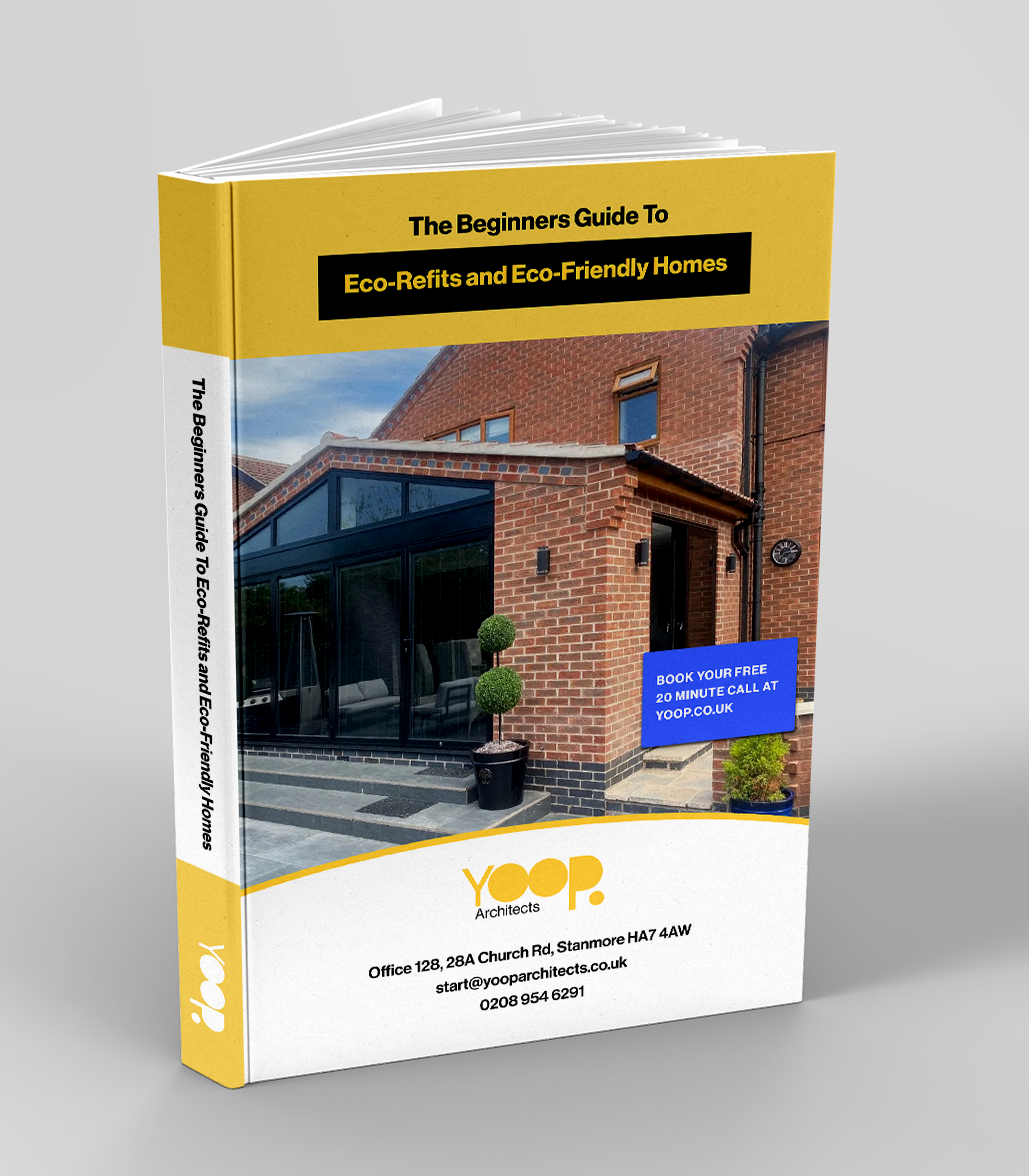
With the current climate that the world is faced with, the importance of living a sustainable lifestyle or Eco-Friendly Homes is paramount in every individual’s life. Home Energy efficiency and design environment impacts give great benefits in terms of reducing personal carbon emission, reducing energy cost as well as improving one’s standard of living whether you are constructing a fresh house or you are refurbishing an old one. This guide is aimed at novices and will explain the concept of eco refits, environmentally friendly interior designs and green remodeling along with the means through which one can develop employability energy effectively and practices sustainable living areas directly or indirectly.
1. What Is Eco Refurbishment?
Eco refurbishment is the process of providing upgrades to improve the ecological performance of any given structure without demolishing it. This means there is a need for the installation of power saving apparatus, use of green resources as well as improving the insulation of the house and the use of energy. The aim is to lessen the energy losses of the house, minimize the waste produced as well as lower h the energy footprints of the structure.
Eco-refits may consist of:
Insulation Enhancements: Enhancing wall, roof and floor insulations to prevent the loss of heat.
Energy-Conserving Windows: Adding double and/or treble glazed windows for better thermal performance.
Upgrading of Heating System: Installing old technology super absorbing warm air units or solar water heaters instead of old ineffective gas boilers.
Alternative Energy: Incorporating onsite energy sources such as solar panels, wind turbines or geothermal systems.
Water Efficiency: Carrying out rain water harvesting or grey water recycling in order to save water.
There are many advantages of adopting eco-friendly home design as well as carrying out green retrofit in one’s house
– Yoop Architects
TWEET THIS
2. Pros of Eco-Refits and Eco – Friendly Houses
There are many advantages of adopting eco-friendly home design as well as carrying out green retrofit in one’s house. These include:-
Cutting down Energy Expenses
One of the first advantages of making eco remodels is the diminished expenses associated with energy consumption. Due to the very nature of energy efficient alterations, re-roofing with better insulation, installing more energy efficient heating appliances, and creating energy such as geothermal hot water, the amount of energy homeowners use is likely to drop significantly hence lower bills.
Enhanced Valuation of Real Estate
Real estate that is energy-efficient is perceived to have a greater market value as almost every home buyer is in search of energy-efficient features these days. Properties built to high environmental standards are generally preferred by the customers, and therefore such properties command better prices.
Brighter Hygge
Energy efficient houses also known as sustainable houses are energy conserving and very comfortable to live in. This is due to better insulation and temperature control materials that promote even distribution of heat while reducing cold drafts in the stock all year round.
Carbon Footprint
Completion of eco refits assists in combating climate change as it curtails energy use and the use of fossil fuels in one’s home. This way, the global population becomes a participant in the fight against global warming by encouraging a healthy way of living.
Healthy Indoor Conditions
Applying safe painting materials and also improving the air circulation and the amount of sunlight received indoors can help in creating a better living environment. Additionally, many eco-friendly homes are able to provide healthier indoor air and do not use toxic chemicals to a great extent.
The essential guide for understanding what eco-refits are and how you can design an eco-friendly home.
Well done!
You are moments away from downloading this guide from Yoop Architects.
Follow the instructions below.
Download Now
What’s in this guide?
In this guide you will learn about refitting your home in an eco-friendly way. You will learn what you can do to make your home more environmentally friendly.
Who is this guide for?
This guide is for anyone who is considering improving their home so it is more efficient and supportive of the environment through low carbon emission and heat saving ideas.
Why should I read it?
To get an idea of what you can do in your home, some things to consider during renovation or design, which are more environmentally friendly.
How do I download it?
Enter your name and email in the boxes above and you will be able to download the PDF immediately. You can download it to your computer to read later or open it in your browser or PDF viewing software.
3. Elements That Make Up An Eco-Friendly Homes
If you are designing or making alterations on an eco-friendly homes, there are some principles, which one ought to pay attention to. These principles assist in constructing a more energy efficient and livable space.
1. Energy Consumption Energy:
Consumption reduces, reuse and recycle when all inclusive will be the aim l energy consumption. In order to do this, building fabric, more efficient appliances and energy management systems will play a major role. Some of the examples of energy consuming sectors are: Smart Thermostats – Using programmable or smart thermostats to optimize heating and cooling. LED Lighting – Using LED light instead of incandescent or fluorescent light. Energy Star Appliances – Using appliances which are energy efficient.
2. Renewable Energy
To lessen your reliance on non-renewable energy, it is necessary to add some renewables. This could be notch: Solar Panels: Solar photovoltaic (PV) panels are used in the domestic context with the aim of minimizing the consumption of grid generated electricity. Solar Water Heaters – Heaters which use solar energy rather than gas or electricity to heat water. Wind Power: Domestic wind turbines in suitable locations generate electricity for household use.
3. Materials that are environmentally friendly
When constructing a house, and even when furnishing, the floor, and all other surfaces, do affect the environmental impact of the home. Materials should be selected such that:
Recyclable or Reused: Use materials that do not most specially new resources such as reclaimed woods, recycled metals, and so on.
From the Region: Using regionally available materials will cut on emissions during transportation.
Safe and Natural: Adopt low odour paints, natural surfaces, and environmental lovers glue in order to enhance air quality at the interiors.
4. Water Efficiency
To prevent water waste particularly in eco-friendly homes is almost impossible. Thus try to include:
Low-Flow Fixtures: substitute high-water consumption toilets, faucets, showers with low-flow types.
Rainwater Harvesting: Use of rainfall for watering plants or many other purposes with the exclusion of drinking.
Grey water Recycling: Use of treated water from baths, kitchens and laundry in flushing toilets or watering flowers.
5. Sustainable Landscaping
Landscaping is designed, the outside of the house is green too. Sustainable landscaping practices can reduce water use and enhance the ecosystem. Important components include:
Native Species: The use of region-appropriate plants makes it easier to avoid over-watering and over-fertilizing.
Previous Paving: The application of porous pavement materials mitigates the effects of excess stormwater runoff and minimizes flooding and water contamination.
Composting: It makes less rubbish and kinder to the earth by having the garden contain a composting system.
FREE GUIDE: Category: Loft Conversions
The Essential Guide to Something
Some information about the guide
Click the button below to download the guide now.
4. Creating an Eco-Refit: What to Build Upon and What’s the First Step To Do?
1. Evaluation of Your Present Home
For instance, speculation, predictions, or assumptions. Before full-scale commencement of an eco-refit, carry out an energy audit looking out for points where the house drafts a […]
2. Determine Your Priorities
Decide which green features will be of value to you more than others. Are you trying to cut down on kitchen energy bills or are you looking to improve the comfort levels within the house or perhaps lessen on the carbon emissions? Reordering the enhancements based on the reasons and scale of the expenses.
3. Talking To Experts
This will include, for example, meeting standard building design guidelines that have regard to eco innovations. Hiring an architect or energy consultant who specializes in ‘green’ architecture is most advisable if you want to draw a plan.
4. Estimating and Sourcing Funds
While every eco-refit will reduce costs for one within a time span, the initial investment will be exorbitant. Look into government-based schemes, subsidized loans, or other financial assistance provided that facilitate undertaking renovations for improving energy efficiency.
5. Do Not Rush into Changes
If achieving a total eco-refit is not possible at this time, proceed with smaller projects for example re-insulating, energy-saving lighting systems or borrowing a smart thermostat installation. Little by little, you can try to reach your aim for a ‘green’ remedy, which is a total overview change.
Share this…
Planning Permission and Regulations
In the UK, Permitted Development Rights (PDR) are applicable to various eco-home improvements, absolving them from the need to obtain planning permission. Such projects as solar panel installations, external insulation, or large extensions may require planning approval given certain criteria, such as location and size of siting. Special conditions apply if the house is listed or in a conservation area. Building regulations permit energy-efficiency changes to comply with sustainability standards, such as Part L energy efficiency requirements.
Latest Innovations and Trends in Eco-Friendly Homes
Green roofs & living walls act as insulation, reduce rainwater runoff, and provide biodiversity.
Smart energy systems: AI-enabled energy monitoring and automation create harmonised energy use.
Hydrogen boilers: an alternative to gas boilers in the future, using clean hydrogen fuel.
Battery storage for solar energy: helps in the storage of excess energy generated by solar panels for use whenever needed.
Environmentally friendly insulation: recycled materials, including sheep’s wool, hemp, and aerogel, which have better insulation properties.
Water recycling systems: include greywater recycling and rainwater harvesting to reduce wastage of water.
What services do Yoop Architects offer?
Yoop Architects specialise in the concept and design of ecologically viable homes and retrofitting existing properties with sustainable alternatives. Our group of experts works with the homeowners to create tailored eco-refits involving comfort, energy efficiency, and sustainability. We can assist with everything from material selection and renewable energy integration to insulation upgrades, making sure that a home is good-looking, environmentally viable, and energy-efficient by high standards.
Conclusion: It is high time everyone adopts Green Living
When it comes to housing, the use of green materials and eco homes is not a passing trend but rather the sustainable era that is coming. Be it for energy preservation, for the benefit of the ecosystem or even for simply building a clean healthy home—eco-friendly homes enhancement is worth the spend. After all, there are smart actions that can be done to improve a customer’s home without any fears of losing the advantages of green building for years to come.
FREE EXPERT HELP TODAY
Thinking of your dream home improvement or how to start your project?
Need your planning questions answered? Talk to an expert today.
Book a FREE 20 Minute Call with one of our home improvement Architects.
Connect with Yoop Architects…
Facebook
Twitter
LinkedIn

